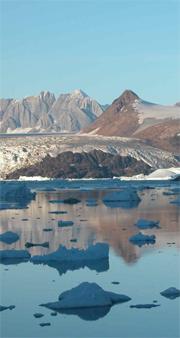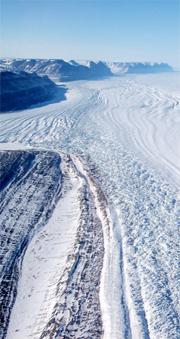 Large numbers of bergs fall each year from the fast-flowing edge of Kangerdlussuaq glacier, east Greenland.© Science/J.A. Dowdeswell
Large numbers of bergs fall each year from the fast-flowing edge of Kangerdlussuaq glacier, east Greenland.© Science/J.A. DowdeswellGreenland's glaciers, which have since the last ice age slipped into the ocean at a sedate, glacial speed, are beginning to pick up the pace.
Research shows that the ice is melting at an accelerating rate, lubricating the whole works and causing some glaciers to shoot out to sea at up to 14 kilometres a year.
The ice sheet is now losing 220 cubic kilometres per year from this calving and melting, say Eric Rignot, of the California Institute of Technology in Pasadena, and Pannir Kanagaratnam of the University of Kansas in Lawrence, who report their findings in this week's Science1. That's twice as much as just a decade ago.
Rising tide
Recent research has shown that most of the continent's ice cap is getting thicker over time, probably due to increases in snowfall. According to a paper published last year2, the middle portion of the island was growing at an average of 79 km3 per year as of 2003.
But the gains aren't making up for the losses, say Rignot and Kanagaratnam.
They estimate that the annual contribution to sea-level rise resulting from Greenland's ice loss is 0.5 millimetres: more than twice as high as estimates from last year. Recent calculations have shown that sea-level rise is accelerating (see 'Sea-level rise is quickening pace').
The figures are a startling reminder of how climate change can alter the environment. But Rignot is quick to point out that the entire continent isn't on the verge of collapse. The melting ice is from "leakage of a big reservoir, rather than a big hole", he says. "I want to make sure people don't get afraid or alarmed by this."
Slip sliding away
Rignot and Kanagaratnam arrived at their figure after calculating the speed of about 30 of Greenland's glaciers using satellite data. Many of them, particularly those on the southern half of the continent, are speeding up.
 Snow falling in the interior of Greenland is building up the ice - but not fast enough to counter the melting.© Science/E. Rignot
Snow falling in the interior of Greenland is building up the ice - but not fast enough to counter the melting.© Science/E. RignotThey had only limited data from some of the glaciers, forcing them to determine annual speeds from a single measurement per year. But more complete data from other glaciers showed a less than 10% variability in glacial speed between seasons, making the single-measurement estimates relatively accurate.
Rignot hopes that those who model the ice of Greenland will take into account these accelerating glaciers. He worries that in the past the whole ice sheet has been treated as "a block of ice".
Jonathan Gregory, a climate modeller from the Centre for Global Atmospheric Modelling in Reading, UK, is not surprised by the results. He notes that the processes that determine the flow speed of Greenland's glaciers, especially in the fastest-flowing sections, are still fairly mysterious, partly thanks to their inaccessibility. "The controls on the ice stream aren't well understood," he says.
William Krabill from NASA's Goddard Flight Center in Virginia says the work agrees with data he has gathered on annual visits to Greenland since 1991. "All of a sudden these glaciers have taken off," he says. "We are trying a major experiment here with climate change. And nobody knows the outcome."
Post a comment to this story by visiting our pacepicks_up.html">newsblog.
